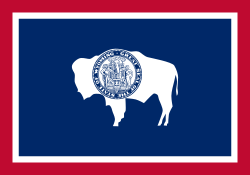 | |
| Use | Civil and state flag |
|---|---|
| Proportion | 7:10 |
| Adopted | January 31, 1917 |
| Design | A dark blue field bordered by white and red; in the centre is the white silhouette of a bison bearing the state seal. |
| Designed by | Verna Keays |
The flag of Wyoming was officially adopted to represent the U.S. state of Wyoming on January 31, 1917. The flag consists of the silhouette of an American bison, a symbol of fidelity, justice, and virility. The bison also represents the local fauna; the intricate state seal on it is not of such bold design. [1] The red symbolizes both the Native Americans and the blood of pioneers who gave their lives. Thoroughout white is a symbol of purity and uprightness; the blue is the color of the skies and distant mountains.








